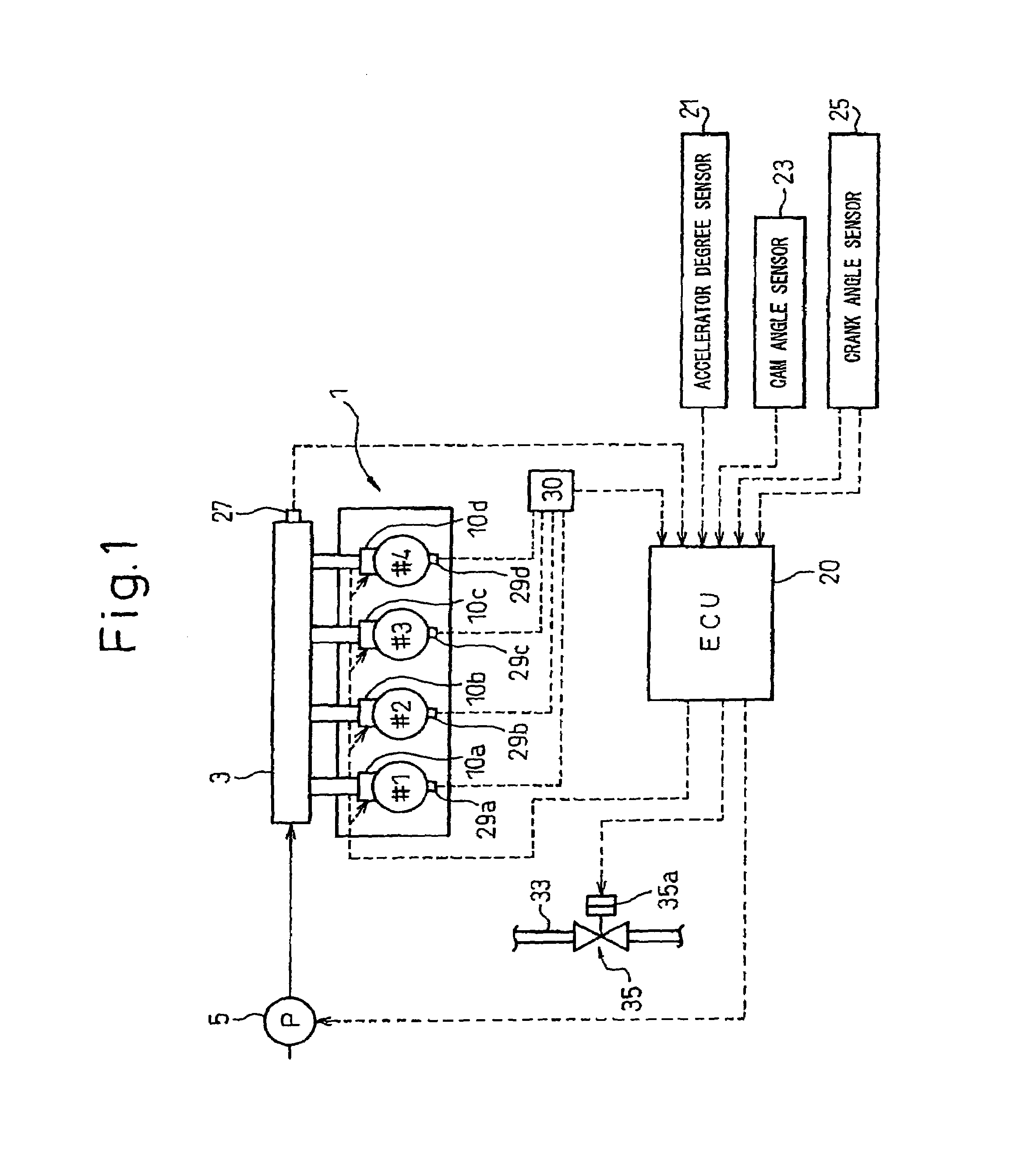However, in a diesel engine, generally the amount of intake air is not adjusted.
Therefore, in a conventional diesel engine, the air-fuel ratio is not strictly controlled as in a
gasoline engine.
With open
loop control, however, it was impossible to prevent error in the actual fuel injection amount compared with the target fuel injection amount and was difficult to accurately control the combustion state to the targeted state.
Further, in a
common rail type
high pressure fuel injection
system designed to be employed in recent diesel engines for improving the combustion state, since the fuel injection period is short and the fuel
injection pressure changes during the injection, there is the problem of a susceptibility to error in the fuel injection amount.
Therefore, in a
common rail type
high pressure fuel injection
system, measures have been adopted such as setting the tolerance of the fuel injectors small so as to improve the fuel injection accuracy, but in practice fuel injectors change in fuel injection characteristics along with the period of use due to wear of the parts etc., so with open
loop control, it is difficult to make the fuel injection parameters constantly accurately match with the target values.
In this way, in a diesel engine, error is liable to occur in the fuel injection amount etc., so even if setting target values giving the optimal combustion state, in practice sometimes making the fuel injection amount match with the target value is difficult.
However, EGR gas has a large effect on combustion.
In particular, in a diesel engine, the amount of EGR gas has a large effect on the
ignition delay time from the start of fuel injection to when the injected fuel starts to burn.
Therefore, if EGR gas is excessively supplied to the
combustion chamber, the engine combustion state will deteriorate and a drop in the engine performance and deterioration of the
exhaust gas properties will occur.
On the other hand, if the amount of EGR gas is small, the effect of suppression of the harmful emissions will fall.
However, conventionally the amount of EGR gas has not been controlled precisely.
If precisely controlling the EGR in this way, a sufficient accuracy cannot be obtained with open
loop control based on the engine speed and accelerator opening degree like in the past.
Further, for example, it is possible to arrange an air-fuel ratio sensor in the engine exhaust passage and to control the amount of EGR gas based on the exhaust air-fuel ratio detected by the air-fuel ratio sensor, but with an engine like a diesel engine which is operated in a state where the exhaust air-fuel ratio is extremely lean, the detection accuracy of the air-fuel ratio sensor falls, so there is the problem that if controlling the amount of EGR gas based on the exhaust air-fuel ratio detected by the air-fuel ratio sensor, the error becomes large.
For this reason, since the change in pressure in a
combustion chamber greatly differs depending on the injection mode or combustion mode as well,
feedback control of the combustion state by just the peak positions or pattern of the heat release rate is not necessarily suitable.
For example, in an in-cylinder fuel
injector of a diesel engine, the injection amount, injection timing, and other fuel injection characteristics gradually change along with the period of use resulting in deviation in fuel injection characteristics, but such deviation in fuel injection characteristics is difficult to accurately correct based on the peak positions or pattern of the heat release rate.
Further, when performing
pilot injection or main fuel injection or after injection or other multi-fuel injection, optimization of the combustion state requires
optimal control of the fuel injection amount and injection timing of the fuel of each, but
feedback control of the fuel injection characteristics of a plurality of fuel injections is difficult based on only the peak positions or pattern of the heat release rate.
As explained above, since the
system of Japanese unexamined Patent Publication (Kokai) No. 2001-123871 feedback controls the
pilot injection amount based on the actually measured
combustion noise, it can keep the
combustion noise below a
target level at all times. However, while the system of Japanese Unexamined Patent Publication (Kokai) No. 2001-123871 keeps the
combustion noise below a target value, it does not necessarily always obtain a good combustion state.
Conversely, sometimes it deteriorates the exhaust properties.
That is, to obtain good exhaust properties, it is necessary to suitably control not only the injection amount of the
pilot injection, but also the injection timing, but the system of Japanese Unexamined Patent Publication (Kokai) No. 2001-123871 controls only the injection amount of the
pilot injection based on the combustion
noise and does not control the injection timing based on the actual combustion state.
Therefore, the system of Japanese Unexamined Patent Publication (Kokai) No. 2001-123871 has the problem that while the combustion
noise falls, the exhaust properties are not always improved.
Further, the system of Japanese Unexamined Patent Publication (Kokai) No. 2001-123871 deals only with
pilot injection and even more so only operation with just one
pilot injection, so has the problem that it cannot suitably control the injection amounts and injection timings of the different fuel injections in multi-fuel injection consisting of a plurality of pilot injections or after injection performed after main fuel injection.
 Login to View More
Login to View More  Login to View More
Login to View More 


